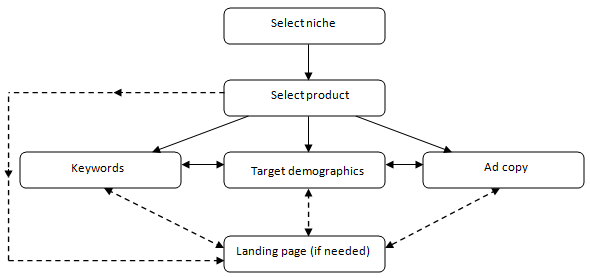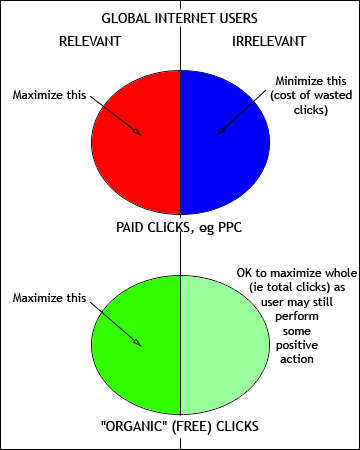 |
|||
|
|
|||
|
Background From Web Design to Internet Mastery Getting Online Making Money Online How to Build a Money Making Website PPC Marketing PPC Marketing 101 PPC Advertising - Make it Work for Your Business Free eBooks Free Internet Marketing eBooks Books Resources Nuts and Bolts |
PPC Marketing 101What is PPC?PPC (Pay per Click) marketing describes the promotion of products/services by means of Web-based ads that are paid for when they generate a click to their specified URL. PPC ads are particularly effective as they appear only on pages relevant to their destination link (as determined by pre-specified keywords), eg on search results for target keywords or content pages featuring those terms. PPC NetworksThere are many PPC advertising networks with the best known including Google AdWords and Facebook Ads. AdWords provides access to the dominant search engine and the huge network of partner sites enrolled in the complementary AdSense program. Facebook Ads offers the advantage of highly specific targeting due to the information held on its registered user base. Starting PPC MarketingAs with any marketing campaign, PPC begins with identifying what you want to market. If you already have a product, that choice is made for you. You may simply want to build brand awareness or generate sign-ups to a list. If you are among the growing number of affiliate marketers and you don’t already have an existing Web site / theme / chosen niche, your first step is to identify a niche to serve. Finding a NicheAn effective niche:
Finding a ProductOnce you have selected a niche the next step is to choose one or more products to promote. When starting out it’s probably easier to focus on one product at a time. Look for a product that:
ClickBank GravityClickBank is a popular affiliate network specializing in digital products. Whether or not you sell ClickBank products, its Website serves as a valuable tool for online marketers. ClickBank Marketplace is the directory of its many products, organized into categories and sub-categories (ie niches). For each product ClickBank provides a statistic called Gravity indicating the performance of the product over the past 12 weeks. Looking at the top products by Gravity within a niche indicates the niche’s profitability. Few products with Gravity over, say, 20 may suggest that it’s hard to squeeze a profit from that niche. Numerous products over, say, 100 might mean the niche is over-sold and thus difficult to break into. Similarly the gravity for individual products suggests potential profitability. You may need to experiment to find the optimal Gravity numbers for your particular market and approach, but one of the nice things about affiliate marketing is the ease of switching in and out of products. Planning a PPC CampaignThe following steps – selecting keywords and demographics, and writing the ad text and (if required) landing page – influence one another and should be carried out in parallel until the campaign works as a whole. 
Keywords and demographics should be selected to:

Keyword ChoiceYour target keyword list determines where your ad appears, eg which search results / content pages. Take time to build an extensive list of so-called “long tail” keywords, ie multi-word phrases that produce a reasonable number of searches. Put yourself in the mind of a target customer, what might they type into a search box? Although you should generate a lengthy keyword list, avoid keywords of low relevance to your campaign. Having ads appear out of context is undesirable for 2 reasons: a) you don’t want to pay for wasted clicks from disinterested visitors, and b) the greater the percentage of your ads that get clicked on the lower cost you will pay per click. DemographicsMany PPC networks allow you to determine the demographics of the target audience for your ads. For example you may be able to select by age, gender, geography etc. Searching sites such as Alexa and Quantcast for leading sites within your niche combined with your existing knowledge and experience can help you target the most appropriate demographics. Ad CopyAssuming appropriate keywords and demographics have been chosen your ads will only appear to (reasonably) interested surfers. Staying within the word limits and other guidelines of your ad network, the ad text should:
Landing PageIn affiliate marketing a landing page is a page on your site that ad clicks are directed to. Landing pages are required if the ad network / affiliate vendor prohibits ad clicks going directly to the vendor’s sales page. You may also choose to have an intermediate landing page to “pre-sell” the product, ie putting the prospect in the mood to buy before directing them to the sales page. An effective landing page should:
Landing Page MathProfit from direct-linking campaign = N x (D x R –C) Profit from landing-page campaign = N x (L x P x R –C) Where:
Usually a direct-linking campaign will be more profitable than one including a landing page. However a quality landing page will make the percentage of pre-sold leads that convert significantly higher than those send by direct link. Monitor and AdjustOnline marketing campaigns are never set in stone. Once a campaign is launched its progress should be monitored. If a campaign features different strands, these should be monitored individually to determine what works most effectively. Minor tweaks to any of the above parts of the campaign can produce significant differences in outcome. Finding what works allows you to do more of it, and lessons can be transferred to other campaigns. |